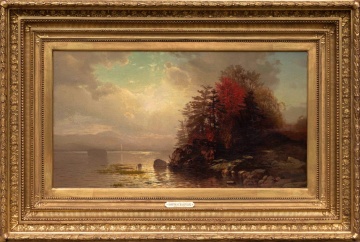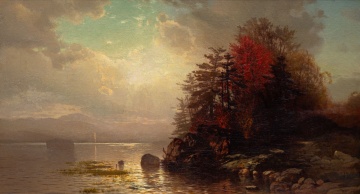Arthur Parton (American, 1842-1914), "Sunset on the Hudson"


Hammer Price w/ BP
$27,600
| Lot #: 175 Arthur Parton (American, 1842-1914), "Sunset on the Hudson" |
|
Oil on canvas. Signed and dated Arthur Parton '74 (lower right). |
| Image: Ht. 17 x W 31 in. Framed: Ht. 29 1/2 x W 43 in. |
|
Provenance Private Corporate Collection, Toronto, Canada. |
|
Condition Relined, overall in-painting to craquelure. |
|
Auction Date Sep 29, 2023 |
Details:
Catalogue Note: Arthur Parton was a successful artist from Hudson, New York who began his career as a Hudson River artist and became one of the few artists who was able to make the transition to the more fluid and poetic style initiated in this country by George Inness, commonly known as the Barbizon School. Parton was fortunate to have been born in a town with a number of eminent painters as neighbors: Thomas Cole was just across the river, Frederick Church had settled on a nearby hill, Sanford Robinson Gifford was a resident of Hudson. Arthur may well have known these artists in his childhood.
At the age of 17, Parton went to the Pennsylvania Academy of Fine Arts to study with William Trost Richards who had developed his style under the influence of Church and Cole as well as the English Pre-Raphaelites. He remained there until 1861. Richards frequently used the typical Cole devices of framing a scene with trees, a body of water dominating the middle ground and a panoramic view of an axial mountain in the background. All of these elements are clearly visible in this particular painting. By 1862, Parton was regularly exhibiting at the National Academy of Design in New York City.
By 1864, Parton had moved to New York City, and continued to exhibit regularly at the National Academy of Design. He was able to spend the years 1869 to 1874 in Europe, first in Paris and then England and Scotland, where he experienced the work of the Barbizon artists for the first time and also encountered the Ruskin Pre-Raphaelites. This was a style that was to supplant the Hudson River School in America. After the American Civil War many American artists, rejected the antebellum Hudson River School concept of landscape as an expression of God's bounty. Instead they looked abroad for inspiration, especially to the Barbizon School of French landscape painting. With loose and heavily loaded brushstrokes they painted personal and romantic responses to the moods of the French countryside. The dominant tones of grey-blue and the darker greens were characteristic of this style.
Upon his return in 1874, he was sufficiently successful to be able to afford a studio at the famous Tenth Street Studio Building, the hub of late nineteenth-century artistic entrepreneurism. Summers were spent either in the Catskill Mountains or the Adirondack region around Keene Valley. Here again Parton was fortunate to share his painting trips with his brother Ernest who was also a painter, and William Hart.
Upon his return from Europe, Parton became known as "the American Corot." Lake George owes a great deal to the two traditions that most influenced Parton: the Cole-like framing devices of the Hudson River painters as well as the luminous sunset effects of light upon the clouds in the background, and the characteristic Barbizon palette. Although Parton stopped exhibiting his work by 1900, partly due to a change in public taste in favor of a more flamboyant Impressionism, he continued to paint for the remainder of his life and died in 1914 after a short bout with pneumonia.
At the age of 17, Parton went to the Pennsylvania Academy of Fine Arts to study with William Trost Richards who had developed his style under the influence of Church and Cole as well as the English Pre-Raphaelites. He remained there until 1861. Richards frequently used the typical Cole devices of framing a scene with trees, a body of water dominating the middle ground and a panoramic view of an axial mountain in the background. All of these elements are clearly visible in this particular painting. By 1862, Parton was regularly exhibiting at the National Academy of Design in New York City.
By 1864, Parton had moved to New York City, and continued to exhibit regularly at the National Academy of Design. He was able to spend the years 1869 to 1874 in Europe, first in Paris and then England and Scotland, where he experienced the work of the Barbizon artists for the first time and also encountered the Ruskin Pre-Raphaelites. This was a style that was to supplant the Hudson River School in America. After the American Civil War many American artists, rejected the antebellum Hudson River School concept of landscape as an expression of God's bounty. Instead they looked abroad for inspiration, especially to the Barbizon School of French landscape painting. With loose and heavily loaded brushstrokes they painted personal and romantic responses to the moods of the French countryside. The dominant tones of grey-blue and the darker greens were characteristic of this style.
Upon his return in 1874, he was sufficiently successful to be able to afford a studio at the famous Tenth Street Studio Building, the hub of late nineteenth-century artistic entrepreneurism. Summers were spent either in the Catskill Mountains or the Adirondack region around Keene Valley. Here again Parton was fortunate to share his painting trips with his brother Ernest who was also a painter, and William Hart.
Upon his return from Europe, Parton became known as "the American Corot." Lake George owes a great deal to the two traditions that most influenced Parton: the Cole-like framing devices of the Hudson River painters as well as the luminous sunset effects of light upon the clouds in the background, and the characteristic Barbizon palette. Although Parton stopped exhibiting his work by 1900, partly due to a change in public taste in favor of a more flamboyant Impressionism, he continued to paint for the remainder of his life and died in 1914 after a short bout with pneumonia.
Shipping Information:
Unlike many auction companies, Cottone Auctions offers a full-service shipping department. We’re equipped to pack and safely ship just about any item to just about any location around the globe.
Learn more >


